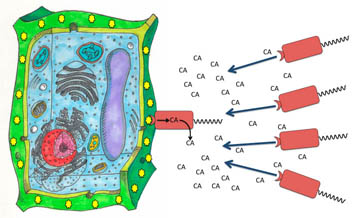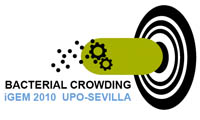Team:UPO-Sevilla
From 2010.igem.org
| Line 26: | Line 26: | ||
[[Image:Figura crowding.jpg|200px|center|frame|<b>Figure 1. Basic elements of the project</b>. Detection of specific polysaccharides on the plant cell wall (yellow stars) by random collision with the plant cells is transduced by the Prh system to activate the synthesis of a CA that is excreted to the medium. The concentration gradient of the CA directs additional bacteria to the vicinity of the plant cell, thus increasing the likelihood of interaction with the specific targets. This results in the synthesis of more CA and the amplification of the response. Eventually, a large population of bacterial cells accumulates on the surface of the plant cell wall.]] | [[Image:Figura crowding.jpg|200px|center|frame|<b>Figure 1. Basic elements of the project</b>. Detection of specific polysaccharides on the plant cell wall (yellow stars) by random collision with the plant cells is transduced by the Prh system to activate the synthesis of a CA that is excreted to the medium. The concentration gradient of the CA directs additional bacteria to the vicinity of the plant cell, thus increasing the likelihood of interaction with the specific targets. This results in the synthesis of more CA and the amplification of the response. Eventually, a large population of bacterial cells accumulates on the surface of the plant cell wall.]] | ||
| - | |||
| - | |||
| - | |||
<!--- The Mission, Experiments ---> | <!--- The Mission, Experiments ---> | ||
Revision as of 11:00, 15 June 2010
Bacterial crowding: Attracting bacteria to non-diffusible surface-attached targets with chemotaxis
Team description
| The UPO-Sevilla team was formed by the initiative of a group of Biotechnology students at Universidad Pablo de Olavide, who learned about the iGEM contest and were interested in participating. Our team is currently made up of five Biotechnology studets (Eva Fernández, David Caballero, Félix Reyes, Adrián Arellano and Paola Gallardo) and one Informatics student (Luis Eduardo Pavón), and is supervised by two professors, Luis Merino (Systems Informatics), and Fernando Govantes (Microbiology). | ||||||||
|
Project outline The possibility of specifically targeting bacteria to biological or abiotic surfaces is a promising technology of potential use in therapy, pest control and bioremediation, among others. However, since in most cases bacteria are not drawn towards their targets, the possibility of specific interaction is limited to those bacterial cells that randomly collide with the surface, thus requiring a high bacterial population to achieve efficient targeting. On the other hand, most bacteria are specifically attracted by gradients of a variety of chemicals, thus achieving high cell densities in the areas where the chemoattractants are present at higher concentration. The aim of this project is to explore the possibility of directing a relatively small population of bacteria to interact efficiently with a non-diffusible target exposed on a biotic or abiotic surface. To achieve this goal, our proposal involves the construction of bacterial strains harboring a two-tiered regulatory circuit involving the following elements: 1. A cell surface-signaling circuit based on the Prh system of Ralstonia solanacearum to detect surface-associated polysaccharides and activate gene expresion. The Prh system has the unique property of detecting a non-diffusible signal present in plant cell polysaccharides and transducing that signal across the outer membrane, the periplasm and the cell membrane to activate transcription by means of the alternative extracytoplasmic function sigma factor PrhI. 2. A gene expression system based on the PrhI-dependent promoter PprhJ engineered to activate the synthesis and excretion of a chemoatractant (CA) suitable for the host bacteria upon interaction with surface-exposed polysaccharides. The expected response is the accumulation of bacterial cells on the polysaccharide-loaded surface, as the initial attachment of a few cells will be amplified by the secondary chemotactic response triggered by the interaction with the surface (Figure 1). | ||||||||
 Figure 1. Basic elements of the project. Detection of specific polysaccharides on the plant cell wall (yellow stars) by random collision with the plant cells is transduced by the Prh system to activate the synthesis of a CA that is excreted to the medium. The concentration gradient of the CA directs additional bacteria to the vicinity of the plant cell, thus increasing the likelihood of interaction with the specific targets. This results in the synthesis of more CA and the amplification of the response. Eventually, a large population of bacterial cells accumulates on the surface of the plant cell wall.
|
 "
"

